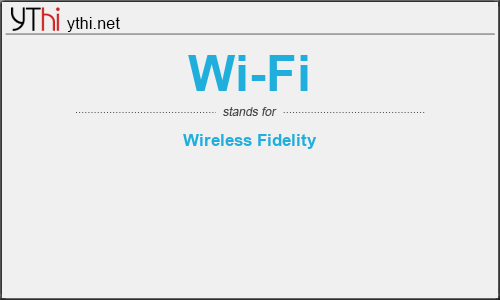What does Wi-Fi mean? What is the full form of Wi-Fi?
The full form of Wi-Fi is Wireless Fidelity.
We all know about Wi-Fi, in our mobile, laptop everywhere Wi-Fi is supported. Wi-Fi is a wireless networking technology, by which we can access network or connect with other computers or mobile using a wireless medium. In Wi-Fi, data are transferred over radio frequencies in a circular range.
Wi-Fi (Wireless Fidelity) is a generic term that refers to the communication standard for the wireless network which works as Local Area Network to operate without using the cable and any types of wiring. It is known as WLAN. The communication standard is IEEE 802.11. Wi-Fi works using Physical Data Link Layer. Nowadays in all mobile computing devices such as laptops, mobile phones, also digital cameras, smart TVs has the support of Wi-Fi. The Wi-Fi connection established from the access point or base station to the client connection or any client to client connection within a specific range, the range depends on the router which provides the radio frequency through Wi-Fi. These frequencies operate on 2 types of bandwidth at present, 2.4 GHz and 5 GHz. All the modern laptops and mobiles are capable of use both the bandwidths, it depends on the Wi-Fi adapter which is inside the device to catch the Wi-Fi signal. 2.4 GHz is the default bandwidth supported by all the devices. 2.4 GHz can cover a big range of areas to spread Wi-Fi signal but the frequency is low, so in simple words, the speed of the internet is less and 5 GHz bandwidth is for a lower range of area but the frequency is high so the speed is very high.
Let’s say, if there is an internet connection of 60 MB/s bandwidth, then for 2.4 GHz bandwidth, it provides approx 30 to 45 MB/s of bandwidth connection and for 5 GHz bandwidth, it provides approx 50 to 57 MB/s bandwidth.
The concept of Wi-Fi is very old but its implementation is not so old. At first ALOHA System is a wireless network system that is used to connect Hawaii island via a network in the year 1971. Where the protocol is used for this was ALOHA protocol and the network used packet transfer. Later it’s converted to IEEE 802.11 protocol.
Then in 1985, the Federal Communications Commission (FCC) released a new network for general uses which works on 900 Mhz, 2.4 GHz, and 5.8 GHz bandwidth. This is known as ISM band. Also, IBM introduced a Token Ring LAN network for connecting several computers, it can transfer data at 4 Mb/s speed. Then in 1988, a wireless cashier system was invented based on the Token Ring LAN network known as waveLAN, it operates at 900MHz or 2.4 GHz band and offers speeds of 1 to 2 Mbps. Then it was converted to IEEE 802.11LAN/MAN standards in 1989. ?Then in 1990, IEEE 802.11 Working Group for Wireless LANs is established by Vic Hayes, he was known as the “Father of WiFi” .
Then in 1994 Dr. Alex Hills introduced a research project on the wireless network, which provided coverage of network to 7 buildings wirelessly.
Then in 1996 Commonwealth Scientific and Industrial Research Organization (CSIRO) introduced a wireless network based on the same protocol 802.11, later it was known as IEEE 802.11a standards.
Then after all this in 1997 the first version of Wi-Fi is released officially which is 802.11 and it can support a maximum of 2 Mb/s link speed. Then in 1999, the link speed is increased to 11 Mb/s over 2.4 GHz frequency band, this version is known as 802.11b
Then after a month, the IEEE 802.11a standard is approved officially, which provides up to 54 Mb/s link speed over 5 GHz band, but the signal range is weaker than 2.4 GHz band.
Then in 2003 the speed is increased in a new version, knows as 802.11g. The speed offers up to 54 to 108 Mb/s over 2.4 GHz.
After this two more versions were introduced that are, 802.11i and 802.11e. In 802.11i, the security mechanism was increased and in 802.11e, Voice over Wireless LAN and multimedia streaming are involved.
Then in 2009, 802.11n is developed, which supports both 2.4 GHz and 5 GHz radiofrequency. And these are used simultaneously by dual-band routers and can reach maximum speeds of 600 Mbps.
Then in 2014, a new version was introduced that offers a potential speed of 1733 Mb/s in the 5 GHz band. This version known as 802.11ac. Till now this is the latest version of Wi-Fi.
WI-FI
means
Wireless Fidelity![]()
Translate Wireless Fidelity to other language.


Leave a Reply
You must be logged in to post a comment.